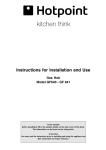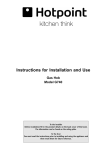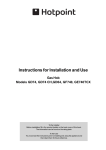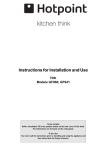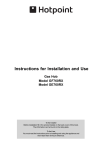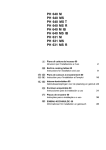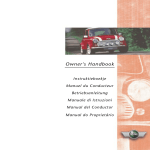Download Creda S830G Specifications
Transcript
Instructions for Installation and Use Gas Hob Model S830G Model S840G CONTENTS Introduction For Your Safety Know your Hob How to use your Hob Practical Advice Care and Cleaning Troubleshooting Installation Electrical Connection Characteristics of Burners and Nozzels Key Contacts 3 4 5 5 6 7 7 8-10 11 12 Back Cover Retention of this Instruction Book This Instruction Book must be kept handy for reference as it contains important details on the safe and proper use of the appliance. If you sell or pass the appliance to someone else, or move house and leave it behind, make sure this Book is also provided so the new owner can become familiar with the appliance and safety warnings. If the Book is lost or damaged a copy may be obtained from: GDA LTD., Morley Way, Peterborough, PE2 9JB 2 Introduction Your new hob is guaranteed* and will give lasting service. This guarantee is only applicable if the appliance has been installed in accordance with the installation instructions detailed in this booklet. To help make best use of your cooking equipment, please read this booklet carefully. The hob is designed specifically for domestic use and responsibility will not be accepted for use in any other installation. * The guarantee is subject to the provisions that the appliance: (a) Has been used solely in accordance with this booklet. (b) Has been properly connected to a suitable supply voltage as stated on the rating plate, attached to the appliance. (c) Has not been subjected to misuse or accident or been modified or repaired by any person other than the manufacturers authorised employee or agent. (d) Has been correctly installed. This appliance conforms with the following European Economic Community directives: - 73/23/EEC of 19/02/73 (Low Voltage) and subsequent modifications; - 89/336/EEC of 03/05/89 (Electromagnetic Compatibility) and subsequent modifications; - 90/396/EEC of 29/06/90 (Gas) and subsequent modifications; - 93/68/EEC of 22/07/93 and subsequent modifications. 3 For Your Safety When used properly your appliance is completely safe but as with any electrical product there are certain precautions that must be observed. PLEASE READ THE BELOW PRECAUTIONS BEFORE USING YOUR APPLIANCE. To maintain the efficiency and safety of this appliance, we recommend you do the following: - only call the Service Centres authorised by the manufacturer. - always use genuine spare parts. NEVER: - attempt to install or repair the appliance without the assistance of qualified personnel. - store items above the appliance that children may attempt to reach. - heat up unopened food containers, as pressure can build up causing the container to burst. - use the appliance to heat up anything other than food. - use the appliance as a room heater. - dry any items on the hob. - install the appliance next to curtains or other soft furnishings. - allow children to play with or tamper with the controls. -leave children unsupervised where cooking appliances are installed as all the cooking surfaces get hot during and after use. - store chemicals, foodstuffs or pressurised containers in or on the appliance, or in cabinets immediately above or next to the appliance. - use flammable or plastic items on or near the hob. - use adapters, multiple sockets and/or extension leads. - fill a deep fat frying pan more than 1/3 full of oil, or use a lid. DO NOT LEAVE UNATTENDED WHILE COOKING. - fry too much food at a time, especially frozen food. This only lowers the temperature or the oil or fat too much, resulting in greasy food. - pull on the appliance or the supply able to unplug it from the electrical outlet. - allow power cables of other appliances to come into contact. - with hot parts of this appliance. - expose the appliance to atmospheric agents, such as rain or sunlight. - operate the appliance with wet hands. - allow anyone to sit or stand on any part of the appliance. - use misshapen pans which may be unstable. - use round base woks directly on the pan supports. - use fish kettles or large preserving pans across two burners. - operate the appliance with wet parts of the body. - operate the appliance when barefoot. ALWAYS: - make sure you remove all packaging and dispose of safely. - check the soundness of the appliance after it has been unpacked. - make sure you understand the controls before using the appliance. - keep children away from the appliance during use. - take care to avoid heat/steam burns when operating the controls. - make sure the controls are turned off when you have finished cooking and when not in use. - take care to avoid heat/steam burns when operating the controls. - disconnect from the power supply, and allow to cool, before cleaning or performing maintenance. - refer servicing to a qualified appliance service engineer. - keep the hob clean as a build up of grease or fat from cooking can cause a fire. - follow the basic principles of food handling and hygiene to prevent the possibility of bacterial growth. - dry food thoroughly before frying and lower it slowly into the hot oil or fat. Frozen food in particular, will cause frothing and spitting if added too quickly. - keep outside of pans clean and free from streaks of oil or fat. - place pans centrally over the burner making sure handles are kept away from the edge of the hob and cannot be heated by other burners/pans. - keep any ventilation slots clear of obstructions. SAFETY ADVICE IMPORTANT - As with any cooking appliance there could be some fire risk attached to the heating of oil, particularly for deep fat frying. Cooking utensils containing oil must not be left unattended (eg. to answer the telephone) on or in close proximity to the cooking areas. IN THE EVENT OF A CHIP PAN OR ANY OTHER PAN FIRE: 1. Turn off the burners. 2. Cover the pan with a fire blanket or damp cloth, this will smother the flames and extinguish the fire. 3. Leave the pan to cool for at least 60 minutes before moving it. Injuries are often caused by picking up a hot pan and rushing outside with it. NEVER USE A FIRE EXTINGUISHER TO PUT OUT A PAN FIRE as the force of the extinguisher is likely to tip the pan over. Never use water to extinguish oil or fat fires. 4 Know your Hob A F B D C A. B. C. D. E. Ignition Button for Gas Burners (only on certain models) F. Safety Device (only on certain models) - Activates if the flame accidentally goes out (spills, drafts, etc.), interrupting the delivery of gas to the burner. Gas Burners Support Grid for Cookware Control Knobs for Gas Burners Ignitor for Gas Burners (only on certain models) How To Use Your Hob The position of the corresponding gas burner is indicated on each control knob. To light a burner, simply press the corresponding knob all the way in and then turn it in the counter-clockwise direction to the "High" setting, keeping it pressed in until the burner lights. This model is fitted with a safety device (F), the knob must be pressed in for about 6 seconds until the device that keeps the flame lighted warms up. Caution: If the burner accidently goes out, turn off the gas with the control knob and try to light it again after waiting at least 1 minute. To turn off a burner, turn the knob in the clockwise direction until it stops (it should be on the “•” setting). The burners differ in size and power. Choose the most appropriate one for the diameter of the cookware being used. The burner can be regulated with the corresonding control knob by using one of the following settings: • Off High Low 5 Practical Advice Practical Advise on Using the Burners For best performance, follow these general guidelines: • Use the appropriate cookware for each burner (see table) in order to prevent the flame from reaching the sides of the pot or pan; • Alwasy use cookware with a flat bottom and keep the lid on; • When the contents come to a boil, turn the knob to "Low". Burner Fast (R) Semi-Fast (S) Auxilliary (A) Triple Crown (TC) Cookware Diameter (cm) 22 - 24 16 - 20 10 - 14 24 - 26 To identify the type of burner, refer to the 'Burner and Nozzle Specifications' section. 6 Care and Cleaning Before cleaning or performing maintenance on your hob, disconnect it from the power supply. • To extend the life of the hob, it should be cleaned carefully and thoroughly on a frequent basis, keeping in mind the following: • The enamelled parts must be washed with warm water without using abrasive powders or corrosive substances which could ruin them. • The removable parts of the burners should be washed frequently with warm water and soap, making sure to remove caked-on substances. • On hobs with automatic ignition, the end of the electronic ignition device must be cleaned carefully and frequently, making sure that the gas holes are not clogged. Stainless steel can be stained if it remains in contact with highly calcareous water or aggressive detergents (containing phosphorous) for an extended period of time. It is recommended that these parts be rinsed thoroughly with water and then dried well. It is also a good idea to clean up any spills. Greasing the Gas Valves Over time, the gas valves may stick or become difficult to turn. If this is the case, the must be cleaned on the inside and the regreased. N.B.: This procedure must be performed by a technician authorized by the manufacturer. Troubleshooting Before calling service for assistance, check through the following list, there may be nothing wrong. First of all, check to see that there are no interruptions in the gas and electrical supplies, and, in particular, that the gas valves for the mains are open. If the burner does not remain on when set to "Low". Check to make sure that: • The gas holes are not clogged. • There are no draughts near the cooking surface. • The minimum has been adjusted correctly (see Installation section, "Minimum Regulation"). If the burner does not light or the flame is not uniform around the burner. Check to make sure that: • The gas holes on the burner are not clogged. • All of the movable parts that make up the burner are mounted correctly. • There are no draughts around the cooking surface. If the cookware is not stable. Check to make sure that: • The bottom of the cookware is perfectly flat. • The cookware is centered correctly on the burner . • The support grids have not been inverted. If, despite all of these checks, the hob does not function properly and problem persists, call Hotpoint Service (see KEY CONTACTS, back page), informing them of: - The type of problem. - The abbreviation used to identify the model (Mod. ...) as indicated on the warranty. If the flame does not stay lit on a model with the Flame Failure device. Check to make sure that: • You press the knob all the way in. • You keep the knob pressed in long enough to activate the flame failure device. • The gas holes are not clogged in the area corresponding to the flame failure device. IMPORTANT: Never call upon technicians not authorized by the manufacturer, and refuse to accept spare parts that are not original. 7 Installation The following instructions are intended for the installer so that the installation and maintenance procedures may be followed in the most professional and expert manner possible. Important: Disconnect the appliance from the electrical supply before performing any maintenance or repair. d) Liquidified petroleum gases are heavier than air and, as a result, settle downwards. Rooms in which LPG tanks are installed must be fitted with ventilation openings to the outside in order to allow the gas to escape in the event of a leak. Therefore, LPG tanks, whether empty or partially full, must not be installed or stored in rooms or spaces below ground level (cellars, ect.). It is also a good idea to keep only the tank currently being used in the room, making sure that it is not near sources of heat (ovens, fireplaces, stoves, etc.) that could raise the internal temperature of the tank above 50°C. Positioning the Hob Important: this unit may be installed and used only in permanently ventilated rooms in accordance with British Standard Codes Of Practice: B.S. 6172 / B.S. 5440, Par. 2 and B.S. 6891 Current Editions.The following requirements must be observed: Installation of Built-in Hobs The gas hob is equipped with type X degree protection against overheating. Therefore, the appliance can be installed next to cabinets, provided the height of the cabinet does not exceed that of the hob. For proper installation of the hob, the following guidlines must be followed: a) If the cabinet(s) located next to the hob are higher than the hob itself, the cabinet(s) must be installed at least 110 mm from the hob edge. b) Hoods must be installed in accordance with the instructions contained in the installation manual for the hoods themselves, and no less than 650 mm from the hob. c) In the case of the 600 mm cooker hoods, besides following the recommendations in point b), the cabinets should be positioned next to the hood at a height of at least 540 mm from the top since this will make it possible to install the lid and move it correctly.The cabinet should always be installed at a height from the top which allows easy use of pots and pans on the cooker. d) Should the hob be installed directly under a cupboard, the latter should be at least 700 mm (millimetres) from the top, as shown in Figure C. a) The room must be fitted with a ventilation system which vents smoke and gases from combustion to the outside.This must be done by means of a hood or electric ventilator that turns on automatically each time the hob is operated. Directly to the Outside (exclusively for cooking appliances) b) The room must have an air flow to allow for proper combustion. This must be 2 m3³/h per kW of installed power. The airflow can be created using an enclosed vent with an inner cross section of at least 100 cm² which must not be able to be blocked. I the appliance does not have a flame failure device, the vent must have an internal cross section of 200 cm3³ (Fig. A). Alternatively the room in which the hob is situated can be vented indirectly through ventilation ducts as specified above, as long as the adjacent room is not a shared area, a bedroom or present any risk of fire (Fig. B). Detail A Adjacent Room 700mm min. Fig. C Room to be Vented 600mm min. 540mm min. In a chimney stack or branched flue. e) The dimensions of the cutout for the appliance must be those indicated in the figure D. Clamps are provided to fasten the hob to counters measuring from 20 to 40 mm in thickness. To fasten the hob securely, it is recommended that all the clamps be used. Fig. D A 55 mm Examples of ventilation holes for comburant air. Enlarging the ventilation slot between window and floor. Fig. A Fig. B 475 mm c) Intensive and prolonged use of the appliance may necessitate supplemental ventilation, e.g. opening a window or increasing the power of the air intake system (if present). 555 mm 8 Installation Gas Connection for the Hob The hob should be connected to the gas supply by an authorized installer. During installation of this product it is essential to fit an approved gas tap to isolate the supply from the appliance for the convenience of any subsequent removal or servicing. Connection of the appliance to the gas mains or liquid gas tanks must be carried out according to the safety standards currently in force, and only after it is ascertained that it is suitable for the type of gas to be used. If not, follow the instructions indicated in the section entitled, “Adapting the Hob for Different Types of Gas”. If the hob is to be connected to tanks containing liquid gas, use pressure regulators that comply with current safety standards. Important: To insure that the appliance operates safety, the gas is regulated correctly and your appliance lasts over time, make sure that gas pressure levels comply with the indications given in Table 1, “Nozzle and Burner Specifications”. Fastening Clamps - Assembly Diagram Clamp Position for H=20mm top Clamp Position for H=30mm top Front Gas Connection to Non-flexible Pipe (copper or steel) Connection to the gas source must be done in such a way as to not create any stress points at any part of the appliance. The appliance is fitted with an adjustable, "L" shaped connector and a gasket for the attachment to the gas supply. Should this connector have to be turned, the gasket must be replaced (supplied with the appliance). The gas feed connector to the appliance is a threaded, male 1/2" connector for round gas pipe. Clamp Position for H=40mm top Back N.B: Use the clamps contained in the "accessory kit." Gas Connection to Flexible Steel Pipe The gas feed connector to the appliance is a threaded, male 1/2" connector for round gas pipe. Only use pipes, tubes and gaskets that comply with current safety codes. The maximum length of the flexible pipes must not exceed 2000 mm. Once the connection has been made, ensure that the flexible metal tube does not touch any moving parts and is not crushed. f) In the event the hob is not installed above a built-in oven, a wood panel must be inserted as insulation. This panel must be placed at least 20 mm from the bottom of the hob itself. Important: When installing the hob above a built-in oven, the oven should be placed on two wooden strips; in the case of a joining cabinet surface, remember to leave a space of at least 45 x 560 mm at the back. m. m 560 Check the Seal Once the hob has been installed, make sure all the connections are properly sealed, using a soapy water solution. Never use a flame. 45 m m. When installing the hob above a built-in oven without forced ventilation, ensure that there are air inlets and outlets for ventilating the interior of the cabinet adequately. 9 Installation Adapting the Hob for DifferentTypes of Gas To adapt the hob to a different type of gas than that for which it was designed, (see the sticker under the hob or on the packaging), the burner nozzles must be changed, as follows: • Remove the pan supports and slide the burners out of the cooktop. • Unscrew the nozzles using a 7mm socket wrench and replace them with those for the new type of gas. (See table 1, “Burner and Nozzle Specifications”). • Reassemble the parts following the instructions in reverse order. • On completing the operation, replace the old rating label with the one showing the new type of gas; the sticker is available from Hotpoint Service (see KEY CONTACTS, back page). If the gas pressure is different than that prescribed, a pressure regulator must be installed at the source, in compliance with national standards governing the use of piped gas regulators. Regulation of Air Supply to the Burner The burners do not need a primary air regulator. Minimum Regulation • Turn the gas valve to minimum. • Remove the knob and turn the regulator screw (positioned either on the side of the top or inside the shaft) clockwise until the flame becomes small but regular. N.B.: In the case of liquid gas, the regulation screw must be fully screwed in (clockwise). • Make sure that, when the knob is turned rapidly high to low, the flame does not go out. • In the event of a malfunction on appliances with the security device (thermocouple) when the gas supply is set at minimum, increase the minimum supply levels using the regulator screw. Once the adjustment has been made, apply sealing wax, or a suitable substitute, to the old seals on the by-pass. 10 Electrical Connection Before connecting to the power supply, make sure that: • the limiter switch and the domestic system can withstand the load from the appliance (see rating plate). • the supply system is efficiently earthed according to standards and laws in force. • the socket or double-pole switch are easily accessible Electrical connection WARNING: THIS APPLIANCE MUST BE EARTHED. The hob is designed to work with alternating current, the supply voltage and frequency indicated on the rating plate (situated under the hob). Make sure that the local supply voltage corresponds to the voltage indicated on the rating plate. when the appliance is installed. Connecting the supply cable to the mains electricity supply For models supplied without a plug, fit a standard plug suitable for the load indicated on the rating plate, onto a cable and connect to a suitable socket. To connect direct to the mains supply, a double pole switch with a contact separation of at least 3mm suitable for the load and complying with current standards and regulations must be fitted between the appliance and the mains supply outlet. The green-yellow earth wire must not be interrupted by the switch. The supply cable must be positioned so that no part of it reaches a temperature of 50°C above room temperature. For installation above a built-under oven, the hob and the oven must be connected separately to the electricity supply, both for safetly reasons and for easy removal of the oven for repair, maintenance etc. DO NOT use adapters as they could cause overheating or burning. Important: the wires in the mains lead are coloured in accordance with the following code: Green & Yellow - Earth Blue - Neutral Brown - Live As the colours of the wires in the mains lead may not correspond with the coloured markings identifying the terminals in your plug, proceed as follows: Connect the Green & Yellow wire to terminal marked “E” or or coloured Green or Green & Yellow. Connect the Brown wire to the terminal marked “L” or coloured Red or Brown. Connect the Blue wire to the terminal marked “N” or coloured Black or Blue. FAILURE TO OBSERVE THE ACCIDENTPREVENTION REGULATIONS RELIEVES THE MANUFACTURER OF ALL LIABILITY. Replacing the cable Use a rubber cable of the type H05RR-F with a suitable cross section 3 x 0.75 mm². The yellow-green earth wire must be 2-3 cm longer than the other wires. 11 Characteristic of the burners and nozzles Table 1 Liquid Gas Burner Diameter (mm) Thermal power kW (p.c.s.*) By-Pass 1/100 Nozzle 1/100 Natural Gas Flow* g/h Nozzle 1/100 Nomin. Ridot. (mm) (mm) *** ** (mm) Flow* l/h Fast (R) 100 3,00 0,70 41 86 218 214 116 286 Semi Fast (S) 75 1,90 0,40 30 70 138 136 106 181 Auxiliary (A) 55 1,00 0,40 30 50 73 71 79 95 Triple Crown (TC) 100 2,50 0,80 48 83 182 179 124 238 28-30 20 35 37 25 45 Nominal (mbar) Minimum (mbar) Maximum (mbar) Supply Pressures * At 15°C and 1013 mbar-dry gas ** Propane P.C.S. = 50.37 MJ/kg. *** Butane P.C.S. = 49.47 MJ/kg. Natural P.C.S. = 37.78 MJ/m3 (1) re. Models with the security device (Ref. F). S R S 830 G S A S A TC R S 840 G 12 20 17 25 Notes 13 Notes 14 Notes 15 Key Contacts After Sales Service Over 1200 trained specialists, directly employed by us, ensure that you can have complete confidence in both the appliances and services we offer. Repair Service and Information Desk UK: 08709 066 066 (Open 8 to 8 Mon - Fri, 8 to 6 Sat, 10 to 4 Sun & Bank Holidays) www.theservicecentre.co.uk Republic of Ireland: 1850 302 200 Note: Our operators will require the following information: Model number: Serial number: Extended Warranties UK: 08709 088 088 (Open 8 to 8 Mon - Sun) www.theservicecentre.co.uk Republic of Ireland: 1850 502 200 Genuine Parts and Accessories UK: 08709 077 077 (Open 8-30 to 5-30 Mon - Fri & 9 to 12 Sat) www.theservicecentre.co.uk Republic of Ireland: (01) 842 6836 General Domestic Appliances Limited, Morley Way, Peterborough, PE2 9JB. 195.039.319.00 May 2003 Part no. FP162 - 01
















